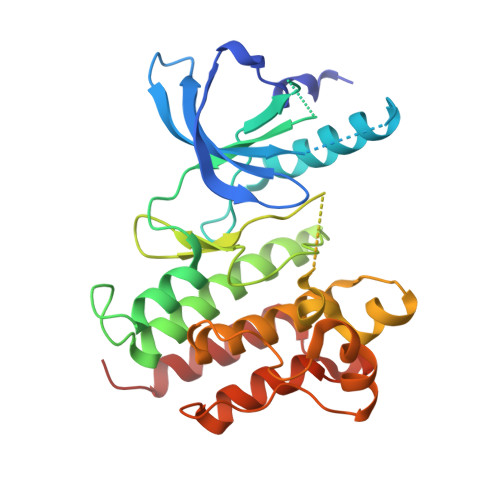Fragment-based lead discovery of indazole-based compounds as AXL kinase inhibitors.
Ng, P.S., Foo, K., Sim, S., Wang, G., Huang, C., Tan, L.H., Poulsen, A., Liu, B., Tee, D.H.Y., Ahmad, N.H.B., Wang, S., Ke, Z., Lee, M.A., Kwek, Z.P., Joy, J., Anantharajan, J., Baburajendran, N., Pendharkar, V., Manoharan, V., Vuddagiri, S., Sangthongpitag, K., Hill, J., Keller, T.H., Hung, A.W.(2021) Bioorg Med Chem 49: 116437-116437
- PubMed: 34600239
- DOI: https://doi.org/10.1016/j.bmc.2021.116437
- Primary Citation of Related Structures:
7DXL - PubMed Abstract:
AXL is a member of the TAM (TYRO3, AXL, MER) subfamily of receptor tyrosine kinases. It is upregulated in a variety of cancers and its overexpression is associated with poor disease prognosis and acquired drug resistance. Utilizing a fragment-based lead discovery approach, a new indazole-based AXL inhibitor was obtained. The indazole fragment hit 11, identified through a high concentration biochemical screen, was expeditiously improved to fragment 24 by screening our in-house expanded library of fragments (ELF) collection. Subsequent fragment optimization guided by docking studies provided potent inhibitor 54 with moderate exposure levels in mice. X-ray crystal structure of analog 50 complexed with the I650M mutated kinase domain of Mer revealed the key binding interactions for the scaffold. The good potency coupled with reasonable kinase selectivity, moderate in vivo exposure levels, and availability of structural information for the series makes it a suitable starting point for further optimization efforts.
- Experimental Drug Development Centre, 10 Biopolis Road #05-01 Chromos, 138670, Singapore. Electronic address: pearly.ng.shuyi@gmail.com.
Organizational Affiliation:

















